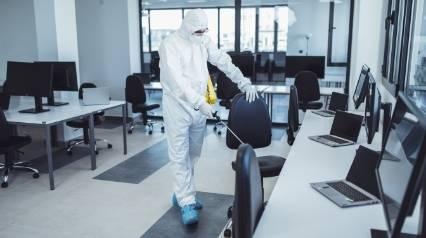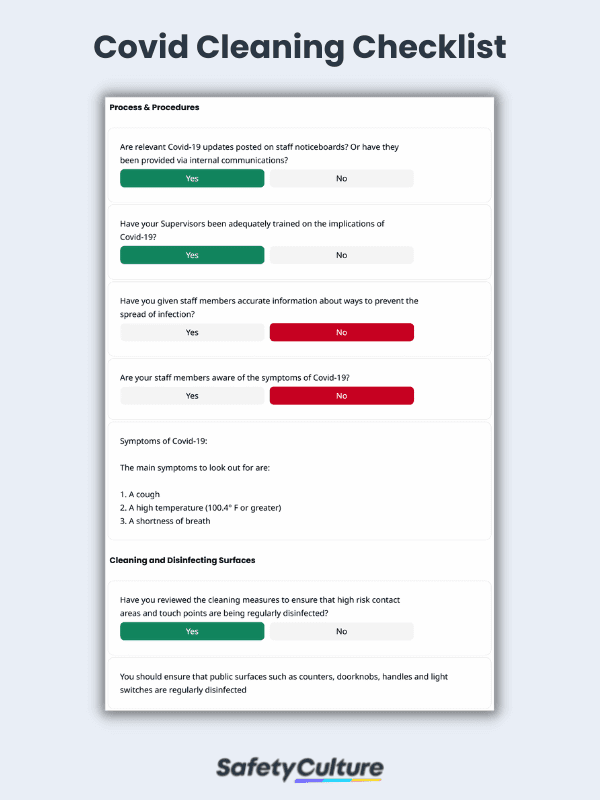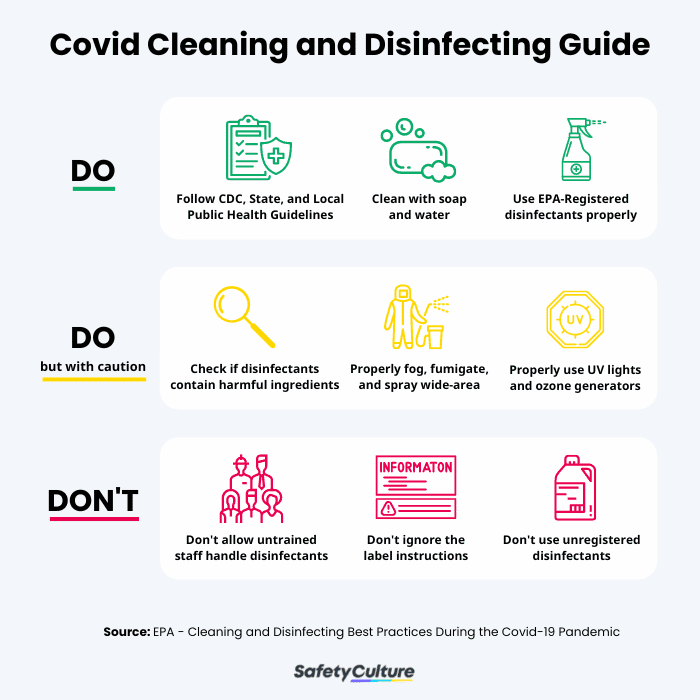What is Covid Cleaning?
Covid cleaning is a cleaning and disinfecting method that follows standard practices according to specific regulations for the type of facility. This practice helps reduce the spread of the virus that causes covid-19. Healthcare facilities and businesses have different cleaning and disinfection minimum requirements.
Why is it Important?
The virus that causes covid-19 is mainly airborne and can land on surfaces. There is a possibility that a person can get infected if they touch the surface and then touch their eyes, mouth, or nose without cleaning their hands beforehand. Even though there is low risk of transmission through surfaces, it is highly recommended to not only clean surfaces but also regularly wash or sanitize hands. Covid cleaning is an important practice to reduce the risk of infection.
How Often Should it be Conducted?
Covid cleaning should be done at least once a day when there’s no confirmed or suspected covid positive employee, customer, or visitor. The CDC explained that this will sufficiently eliminate or decrease the likelihood of spreading the virus.
Additional measure to include is to disinfect surfaces. Disinfection kills any remaining germs or viruses which further reduces risks of covid infection. Another reminder from the CDC is to clean and disinfect shared spaces more often. High traffic areas are more prone to spreading bacteria since surfaces in these areas are used more frequently.
Clean and disinfect the area within 24 hours if there is any sick, confirmed, or suspected covid-19 positive person in the workplace or facility.
General Guidelines for Businesses
OSHA’s best practices for covid cleaning during the pandemic is to create a plan, determine if disinfection is necessary, develop a routine, select proper cleaning supplies, inform and train employees, and lastly, evaluate the effectiveness of the cleaning method used. To break it down further, here are best practices for safe and effective cleaning as provided by OSHA:
- Develop a plan – OSHA stated that even without a pandemic, businesses should have a written SOP for cleaning and a schedule on when to clean or sanitize. Cleaning and sanitizing should be done periodically.
- Determine whether a surface should be disinfected – As previously stated, cleaning can be done once a day for day-to-day operations. All purpose cleaning products can be used for cleaning. Disinfecting should be done when the surface is in a high traffic area or is frequently touched. Another recommendation is to disinfect when there is a sick, suspected, or confirmed covid positive staff.
- Routine cleaning of high traffic areas – OSHA states that this includes workstations, counter tops, light switches, railings, doorknobs, machinery, electronics, and equipment
- Select cleaning products and disinfectants – If disinfection should be performed, it is highly recommended to use disinfectants that are registered by the U.S Environmental Protection Agency (EPA) List N Disinfectants for Use Against SARS COV-2. Avoid using bleach if there’s any asthmatic employees.
- Training employees – Employers are responsible for informing and training the employees on the proper method of cleaning and disinfection. The employers should also teach employees the different types of products and which should be used on certain surfaces. Some cleaning and disinfection materials can be dangerous if used incorrectly. An example of the proper procedure for cleaning a restroom is to start from high to low, dry before wet cleaning activities, and towards the doorway.
- Evaluate – after a certain amount of time, check whether the implemented plan is effective and get feedback from the staff.
FAQs
Officially named COVID-19 by the World Health Organization (WHO) on February 11, 2020, the respiratory disease is caused by the SARS-CoV-2 virus that was first detected in Central China’s city of Wuhan on December 8, 2019. COVID-19 has then spread to almost all countries with over 16 million confirmed cases worldwide.
The flu and COVID-19 are both respiratory diseases with similar symptoms, but they are caused by two different viruses. Here are some similarities and differences between COVID-19 and the flu.
Similarities
|
Differences
|
In the absence of a medically approved vaccine for COVID-19, people are advised to follow precautionary measures to avoid getting infected and mitigate the further spread of the disease.
The Centers for Disease Control and Prevention (CDC) provides some recommendations for individuals and families.
Prepare
- Be alert for any update from public health officials regarding COVID-19 in your community.
- Consider household members who are at greater risk such as older adults and those with severe chronic illnesses and take actions to reduce the risk of getting infected.
- Update your emergency contact list that includes household members, community resources, and healthcare providers.
- Follow preventive measures such as frequent proper washing of hands, disinfection of frequently touched objects, and avoid touching eyes, nose, and mouth.
- Use recommended checklists provided by schools or institutions to check if students, parents/guardians, or staff can report to the school or should stay at home and inform the school/employer.
- Prepare a room that can be used for isolation in case a household member gets sick.
Act (in case of an outbreak)
- The CDC recommends seeking immediate medical attention if you develop these emergency warning signs for COVID-19. However, this list is not all-inclusive. Please consult your medical provider for any other symptoms that are severe or concerning.
- Difficulty breathing or shortness of breath
- Persistent pain or pressure in the chest
- New confusion or inability to arouse
- Bluish lips or face
- Practice social distancing or maintaining distance from people as much as possible (6 feet).
- Stay away from others who are currently ill.
- For older adults and those with severe chronic illnesses:
- Stay at home and away from crowds as much as possible;
- have several weeks’ worth of medication and supplies if staying at home; and
- observe good hand hygiene.
- Cooperate with contact tracing efforts to better contain any outbreak in communities.
With changes to regulations and how things are supposed to be done in order to adapt to what’s called the “new normal,” businesses and organizations have implemented processes to comply with directives to stay in operation and contribute to the effort of keeping stakeholders safe. New checklists and templates—such as COVID-19 symptoms checklist, covid sign-in sheet, and covid 19 cleaning and disinfection log template—are being followed to help keep covid at bay.
The spread of COVID-19 has impacted businesses and industries worldwide, and it is best for employers to determine ways to prevent COVID-19 from becoming an occupational hazard. Businesses and organizations can practice the following to mitigate risks in the workplace:
- Observe proper information dissemination in the workplace and cascade guidelines that employees can follow regarding COVID-19.
- Read and understand the CDC’s recommendation for employers:
- Employees should be informed and encouraged to stay at home when they’re not feeling well.
- Employees who are sick or become sick while in the workplace should be separated from other employees and sent home.
- Educate employees on proper hand hygiene and respiratory etiquette.
- Employers should encourage employees to take a free online course on COVID-19 etiquette.
- Environmental cleaning should be routine. Frequently touched surfaces should always be cleaned.
- Employees who travel are encouraged to check out travel advisories from the CDC website and follow the recommendation for each country.
- Employers should have a risk assessment conducted in the workplace to determine the level of risk of infection and come up with corresponding mitigation.
- Implement visitor or customer screening or sign-in sheets at every entrance to your business establishment.
- There are new regulations that require businesses to implement strict compliance with wearing face coverings within establishments. Non-compliance can lead to the shutdown of operations.
- In places where regulations do not require face coverings, business owners can enforce the wearing of face coverings within the premises for the safety of employees and other customers.
COVID-19 is the latest pandemic to impact the world with confirmed cases increasing exponentially every day. In the absence of a vaccine, the best defense against COVID-19 is to ensure that recommended protocols are followed to prevent getting infected and control its spread. SafetyCulture is a powerful inspection tool that can help make sure that steps are taken to mitigate the spread of COVID-19. With SafetyCulture, you can:
- Follow recommended steps to prevent the further spread of COVID-19
- Proactively catch areas of concern and act quickly to correct vulnerabilities
- Immediately submit reports to provide updates to intended recipients
- Edit COVID-19 checklists to fit the unique needs of your organization
SafetyCulture provides the checklists, templates, and summaries below on a non-site specific and generic basis, and only for informational purposes. By using or downloading any of the checklists or templates, you are doing so at your own risk. You acknowledge that each checklist or template is not a substitute for professional advice.



